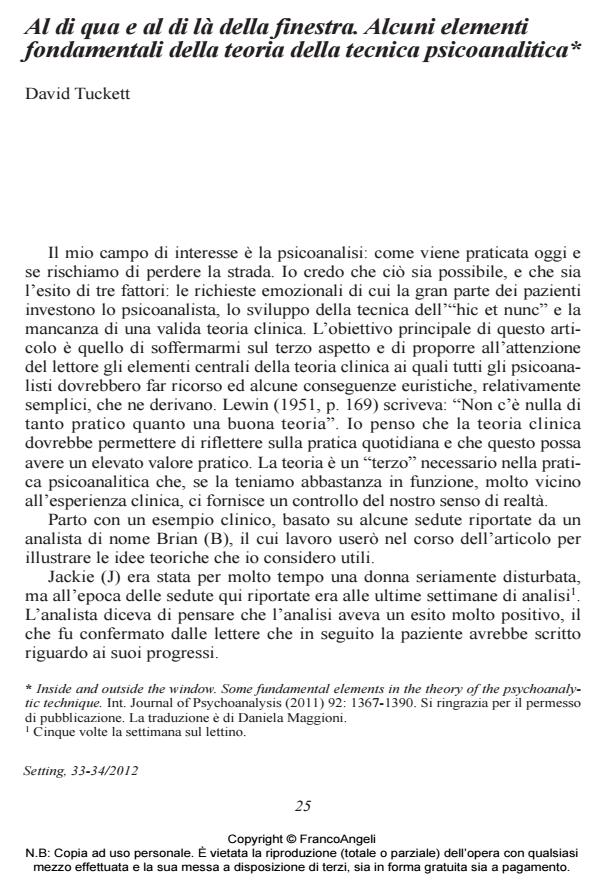Al di qua e al di là della finestra. Alcuni elementi fondamentali della teoria della tecnica psicoanalitica
Titolo Rivista SETTING
Autori/Curatori David Tuckett
Anno di pubblicazione 2014 Fascicolo 2012/33-34
Lingua Italiano Numero pagine 32 P. 25-56 Dimensione file 126 KB
DOI 10.3280/SET2012-033002
Il DOI è il codice a barre della proprietà intellettuale: per saperne di più
clicca qui
Qui sotto puoi vedere in anteprima la prima pagina di questo articolo.
Se questo articolo ti interessa, lo puoi acquistare (e scaricare in formato pdf) seguendo le facili indicazioni per acquistare il download credit. Acquista Download Credits per scaricare questo Articolo in formato PDF

FrancoAngeli è membro della Publishers International Linking Association, Inc (PILA)associazione indipendente e non profit per facilitare (attraverso i servizi tecnologici implementati da CrossRef.org) l’accesso degli studiosi ai contenuti digitali nelle pubblicazioni professionali e scientifiche
Il tema su cui si fonda questo articolo è il pericolo che la psicoanalisi come viene oggi praticata corre di perdere la sua specificità e quindi di perdere la sua strada. L’Autore sostiene che ciò è possibile per tre motivi: il problema in cui si imbattono gli analisti nel rispondere alle forti richieste emozionali che necessariamente la grande maggioranza dei pazienti pone loro, le non ben esplicitate conseguenze dell’apparente successo della "tecnica del qui e ora" e la mancanza di una buona teoria clinica. Questo articolo esamina principalmente le idee dell’Autore circa alcuni punti centrali della teoria clinica che tutti gli psicoanalisti devono usare quando sono al lavoro e propone (con il rischio della semplificazione) alcune euristiche relativamente semplici riferite a tali punti, che possono essere utili. Rifacendosi alla massima di Kurt Lewin secondo la quale "non c’è niente di tanto efficace praticamente quanto una buona teoria", si sostiene che la continua riflessione su come usiamo la teoria nella nostra pratica quotidiana è altamente pratica, se la teoria è abbastanza buona. La teoria, infatti, è un "terzo" necessario nella prassi psicoanalitica: se tenuta in sufficiente conto nel nostro lavoro, in un’opportuna vicinanza all’esperienza clinica, essa fornisce un monitoraggio continuo e molto necessario del nostro senso di realtà. Naturalmente, in quanto terzo, può essere il focus sia dell’amore sia dell’odio, proprio come la realtà stessa, con le stesse problematiche conseguenze. L’articolo si apre con l’esempio clinico di un’analisi difficile ma apparentemente ad esito positivo che è vicina al termine; esso viene usato nel corso di tutto l’articolo per illustrare e approfondire le idee teoriche in esso proposte
David Tuckett, Al di qua e al di là della finestra. Alcuni elementi fondamentali della teoria della tecnica psicoanalitica in "SETTING" 33-34/2012, pp 25-56, DOI: 10.3280/SET2012-033002